Transcription of Coping with Change
1 IN AMERICA 2017 SNAPSHOT: Coping with ChangeA Stressful Political Climate ContinuesTo better understand political stressors and assess any potential for long-term effects, APA commissioned an additional survey in early January 2017, asking Americans again to rate the sources of their stress, including the political climate, the future of our nation and the outcome of the 2016 presidential election. This new survey found that between August 2016 and January 2017, Americans overall average reported stress level rose from to on a 10-point addition, in the January 2017 survey, more than half of Americans (57 percent) report that the current political climate is a very or somewhat significant source of stress. Two-thirds (66 percent) say the same about the future of our nation, and nearly half (49 percent) report that the outcome of the election is a very or somewhat significant source of stress.
2 POLITICAL ISSUESSTRESSING AMERICANS(% reporting very/somewhat significant source of stress)Results from January survey57 %66%49%THE CURRENT POLITICAL CLIMATETHE FUTURE OF OUR NATIONTHE ELECTIONOUTCOMES tress in America 2017 Snapshot: Coping with Change Since 2006, the American Psychological Association s (APA) Stress in America survey has examined sources of stress and its impact on the health and wellbeing of Americans living in the United States. Since that first survey, overall stress levels have gradually decreased for Americans, with results from our August 2016 poll showing the lowest overall reported stress level in 10 years. However, an additional poll conducted in early January 2017 shows more Americans reporting symptoms of stress and citing personal safety and terrorism as sources of to our 2016 poll, top stressors for the American population remained steady, with Americans being most likely to report money, work and the economy as very or somewhat significant sources of stress in their the spring of 2016, however, APA s member psychologists began reporting that their patients were increasingly concerned and anxious about the 2016 presidential election.
3 Based on this feedback, we inquired for the first time about Americans stress related to this added election-related questions to its annual poll, conducted in August 2016 by Harris Poll on behalf of APA, and in October 2016 released initial data regarding Americans stress related to the upcoming election. The August survey found that more than half of Americans (52 percent) reported the 2016 presidential election was a very or somewhat significant source of stress. On a 10-point scale, where 1 is little or no stress and 10 is a great deal of stress, those who found the election to be a very or somewhat significant source of stress reported a higher overall average stress level than those who reported that the election was not a very significant or not at all a significant source of stress ( vs.)
4 , respectively).The August survey revealed that social media conversations about politics and culture have had an impact on Americans stress. Nearly four in 10 adults (38 percent) said that political and cultural discussions on social media caused them stress. In addition, adults who used social media were more likely than adults who did not use social media to say the election was a very or somewhat significant source of stress (54 percent vs. 45 percent, respectively). IN AMERICA 2017 SNAPSHOT: Coping with Change1 Note: Small base. Results are directional in Democrats were more likely than Republicans (72 percent vs. 26 percent) to report the outcome of the 2016 presidential election as a significant source of stress, a majority of Republicans (59 percent) said the future of our nation was a significant source of stress for them, compared to 76 percent of Outcome Concerns Vary Among Demographic GroupsIn the January survey, almost seven in 10 (69 percent) Blacks, 57 percent of Asians, 56 percent of Hispanics of any race (hereafter, Hispanics, and also included in survey as people of color) and 42 percent of non-Hispanic Whites (hereafter, Whites), said that the outcome of the election was a very or somewhat significant source of stress.
5 Stress differed among age demographics as well: More than half (58 percent) of Millennials, 48 percent of Matures1, 45 percent of Boomers and 39 percent of Gen Xers consider the election outcome as a very or somewhat significant source of education levels, 53 percent of those with more than a high school education reported very or somewhat significant stress related to the election outcome, compared to 38 percent of those with a high school education or less. Additionally, a greater percentage (62 percent) of Americans who reside in urban areas said the same, compared with those who live in suburban (45 percent) and rural (33 percent) About Safety Also On the RiseThe January survey also found an increase in the percentage of Americans reporting stress related to safety and the future.
6 Since August, the percentage of Americans saying personal safety is a very or somewhat significant source of stress increased from 29 percent to 34 percent the highest percentage noted since the question was first asked in 2008. 2008201020122014201620092017201120132015 30%29%23%29%27%34%32%30%30%31%STRESS BECAUSE OF PERSONAL SAFETY(% reporting very/somewhat significant source of stress)ELECTION OUTCOME STRESS ACROSS GEOGRAPHICAL AREAS(% reporting very/somewhat significant source of stress)URBANSUBURBAN45%RURAL33%62%Result s from January IN AMERICA 2017 SNAPSHOT: Coping with ChangeAUGUST2016 JANUARY2 01747%53%HISPANICS27%35%WHITES68%71%BLAC KS42%57 %ASIANSAMERICANS NOW MORE LIKELY TO STRESS OVER POLICE VIOLENCE TOWARD MINORITIES(% reporting very/somewhat significant source of stress)In addition, the percentage of Americans saying acts of terrorism are a very or somewhat significant source of stress increased from 51 percent to 59 percent from August 2016 to January The percentage of Americans saying police violence toward minorities was a very or somewhat significant source of stress also increased from 36 percent to 44 percent in the same five-month period.
7 Among White Americans, the percentage for whom this is a significant source of stress increased from 27 percent to 35 percent. Slight increases were also seen among non-White Americans during the same time period (Hispanic rose from 47 percent to 53 percent; Black rose from 68 percent to 71 percent; Asian rose from 42 percent to 57 percent).3 Increased Stress Raises Health ConcernsThe additional stress is also affecting our health. The percentage of Americans who reported experiencing at least one symptom of stress over the past month rose from 71 percent in August 2016 to 80 percent in January 2017. This includes physical and emotional symptoms such as headache (34 percent), feeling overwhelmed (33 percent), feeling nervous or anxious (33 percent), or feeling depressed or sad (32 percent).
8 We know that chronic stress can take a toll on a person s health. It can make existing health problems worse, and even cause disease, either because of changes in the body or bad habits people develop to cope with stress. The bottom line is that stress can lead to real physical and emotional health consequences, said Katherine C. Nordal, PhD, APA s executive director for professional practice. Stress Snapshot: Looking Back; Looking ForwardThe results of the January 2017 poll show a statistically significant increase in stress for the first time since the survey was first conducted in 2007. Average reported stress levels declined between 2007 and 2012. Although reported stress levels increased slightly in 2013 and again in 2015 the increases were not statistically the August survey, three in 10 Americans (31 percent) say that their stress has increased in the past year and a sizeable proportion (20 percent) reported experiencing extreme stress (a rating of 8, 9 or 10 on the 10-point scale).
9 While people s short-term stress levels may have increased, reducing stress in the future continues to be a priority for some. 2 The January 2017 survey was conducted before President Donald J. Trump s executive order, Protecting the Nation from Foreign Terrorist Entry into the United States issued Friday, January 27, 20173 The base size for Native Americans was too low to report.. IN AMERICA 2017 SNAPSHOT: Coping with ChangeExercising or walkingGoing onlineWatching TV (2 hrs or more/day) Spending time with friends or familyReadingPrayingEating46%31%33%30%31 %23%18%48%32%39%44%44%40%26%STRESS MANAGEMENT METHODS ACROSS GENDERS The August survey asked people to reflect on the past and think about the future, and three in 10 Americans (31 percent) wish they had spent less time worried or stressed in the past 10 years.
10 Even more (36 percent) report that reducing stress is a priority over the next several , Work and Economy Remain Consistent StressorsAdditional top causes of stress in 2016 were similar to those of past years, as Americans report money, work and the economy as very or somewhat significant sources of stress in their lives (61 percent, 58 percent and 50 percent, respectively).When asked about topics that have added to their stress levels over the past decade, Americans are most likely to cite the economy (44 percent), terrorism (34 percent) and mass shootings and/or gun violence (31 percent).In August, the majority of Americans said they anticipate that money (62 percent), the economy (58 percent), personal health concerns (58 percent) and health problems affecting family (57 percent) will be somewhat or very significant sources of stress in the next several from August surveyECONOMY44%TERRORISM34%MASS SHOOTINGSAND/ORGUN VIOLENCE31%MOST COMMONLY REPORTED FACTORS ADDING TO STRESS IN THE PAST 10 YEARSR esults from August IN AMERICA 2017 SNAPSHOT.














